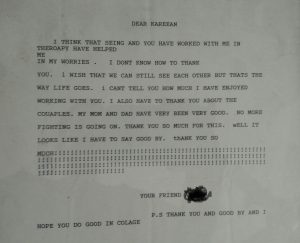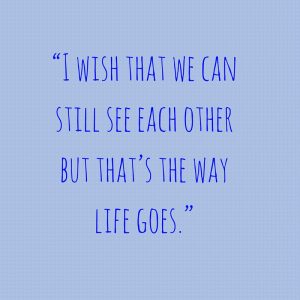 Over twenty years ago, when I was completing the final of two eight-month-long clinical internships for my Masters of Social Work degree, I had to say good-bye to the clients I had been seeing as their therapist. Back then, and perhaps still, the clinical term for this process was “termination,” which is quite a negatively-connoted term for a very tender and exquisite process.
Over twenty years ago, when I was completing the final of two eight-month-long clinical internships for my Masters of Social Work degree, I had to say good-bye to the clients I had been seeing as their therapist. Back then, and perhaps still, the clinical term for this process was “termination,” which is quite a negatively-connoted term for a very tender and exquisite process.
So much happens in a good-bye. So much is possible – echoes of past departures are very much present, whether of a good nature or a painful nature. Attention to good-byes can foster healing for past ones that did not go so well for whatever reason. It takes insight and intention, the lion’s share that lands on the shoulders of the clinician, though not solely, for clients, too, must bring their willingness to engage thoughtfully in the process, as well, for it to be the best it can be.
I was working at a community mental health center in a multi-cultural suburban center outside a major urban center. My focus was children and families. In both my internships, my favorite category of client was ten-year-old boys. In this setting, early on, I began working with Abdul (not his real name). He was referred because of some problems at school. He was definitely anxious, which was stoking his disruptive behavior at school. But his anxiety was actually not his symptom, but a symptom of a wider family issue. Once this was uncovered, and his parents entered first into family therapy, then into couples therapy, to work on the germ of the problem, Abdul’s worrisome behaviors disappeared. It was a textbook version of how good therapy works in a family system.
The ending of his play therapy coincided with the end of my internship and so we entered into the “termination” process – the process of saying good-bye. As a way to help Abdul have closure, given his age, the need for something concrete, and a few other factors, he and I decided that he would write me a letter.
An image of the letter (which I framed and have kept these twenty years) is below. Below that, because the text in the image is so small, are the words he wrote to me. (Abdul was super smart; his spelling and grammar reflect that English was not his first language.)
I THINK THAT SEING AND YOU HAVE WORKED WITH ME IN THEROAPY HAVE HELPED
ME
IN MY WORRIES . I DON’T KNOW HOW TO THANK
YOU. i WISH THAT WE CAN STILL SEE EACH OTHER BUT THAT’S THE WAY LIFE GOES.
i CANT TELL YOU HOW MUCH I HAVE ENJOYED WORKING WITH YOU. I ALSO HAVE TO THANK YOU ABOUT THE COUAPLES. MY MOM AND DAD HAVE BEEN VERY GOOD. NO MORE FIGHTING IS GOING ON. THANK YOUSO MUCH FOR THIS. well IT LOOK LIKE I HAVE TO SAY GOOD BY. thank YOU SO MUCH !!!!!!!!!!!!!!!!!!!!!!!!!!
!!!!!!!!!!!!!!!!!!!!!!!!!!!!!!!!!!!!!!!!!!!!!!!!!!!!!!!!!!!!!!!!!!!!!!!!!!!!!!!!!!!!!!!!!!!!!!!!!!!!!!!!!!!!!!!!!!!!!!!!
!!!!!!!!!!!!!!!!!!!!!!!!!!!!!!!!!!!!!!!!!!!!!!!!!!!!!!!!!!!!!!!!!!!!!!!!!!!!!!!!!!!!!!!!!!!!!!!!!!!!!!!!!!!!!!!!!!!!!!!!
!!!!!!!!!!!!!!!!!!!!!!!!!!!!!!!!!!!!!!!!!!!!
YOUR FRIEND (Abdul)
P.S. THANK YOU AND GOOD BY AND I HOPE YOU DO GOOD IN COLAGE
So wise, that little guy: Here’s my wish. Here’s reality. They aren’t the same. Let’s name and hold them both without grasping, without adding suffering onto the pain. Here’s my wish. Here’s reality. As simple as that.
There are four weeks left in my two-year internship as a minister. So I am thinking all the time about good-byes, especially with the folks who have been my faithful companions these past nearly two years.
I think the best good-byes – and by best, I mean, the healthiest – are ones in which both participants get to have some say in how it happens. In my previous clinical social work world, we would call this “a sense of agency.” Simply put, this means choice of action.
The example that comes to my mind comes from the world of parenting wisdom. A young child may not have the choice that they must wear their coat, but they do get to choose whether they put it on themselves or have their loving adult do it for them. That choice of how to put the coat on is an exercise in agency.
If the moment is not of one’s choosing, then it is important that one gets to choose how to enter or how to engage the moment. This is especially important if the good-bye is one that brings on difficult emotions – sadness, regret, echoes of other losses, a sense that it is not of one’s choosing.
 So this might mean that I get to say good-bye to you with my words, or by not looking at you in the face but listening. I get to say good-bye to you directly or I get to avoid seeing you at all in the final weeks. I get to hug you or I get to leave you a text message at a time of my choosing (which may be before you leave or many weeks or month afterwards).
So this might mean that I get to say good-bye to you with my words, or by not looking at you in the face but listening. I get to say good-bye to you directly or I get to avoid seeing you at all in the final weeks. I get to hug you or I get to leave you a text message at a time of my choosing (which may be before you leave or many weeks or month afterwards).
I think the best good-byes – and by best, this time I mean, touched by a spiritual sensibility – are ones in which there is intentionality, ritual, and embodiment. By intentionality, I mean that we enter into the good-bye by facing it, rather than turning away or trying to avoid. By ritual, I mean that we create a special, perhaps even sacred, structure to communicate that our relationship, including its dissolution, is worthy of ceremony. By embodiment, I mean that it is good to have some object that we imbue with commemoration of our shared relationship and which we can choose to keep as a reminder for as long as it is helpful. This is especially important for children (whose abstract thinking capacity is still developing), but can be important across the life span.
One of my tasks this week is to make a good-bye video for the children and youth at the church (though no one is going to stop adults from watching it). There will be other chances for good-byes: in person, during Time for All Generations in worship, at coffee hour. This video will serve multiple purposes: it will be available for the kiddos to watch when they want; it will be a tool for parents to use as they see the need; and it will help me to make concrete this process of raising up as worthy the relationships that we have developed over these past two years and which we bring to a close, except in our hearts.
I’m still trying to work out what the video will be – I’m finding it much more challenging than I expected. Which is a bit strange, as usually, I’m stoked for this kind of creative project.
It’s probably because even though I am ready for the end of this chapter of my ministry and the beginning of another one, I am sad. I am sad to bring to a close such nurturing, kind-hearted relationships that have brought me such joy. I am sad that I won’t know about the moments and milestones, the joys and sorrows, of the people whom I have companioned these past two years. I am sad to be leaving First Parish Church of Groton.
“I wish that we can still see each other but that’s the way life goes.”
In the coming weeks, may I live into this wisdom shared with me twenty years ago by a young boy who must now be a thirty year old man, whom I do not know, but who lives still in a small place in my large heart, as I hope I do in his.


Tears of goodbye, happiness because our paths crossed, sadness that we won’t see each other, joy for your achievements, gratitude for what we shared, heart filled with love and peace always.
Yes, all that, yes. So it is with much of life! Peace to you as well.
peace to you, I, too, am glad our paths have crossed!